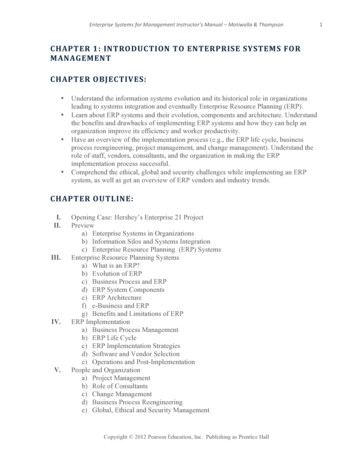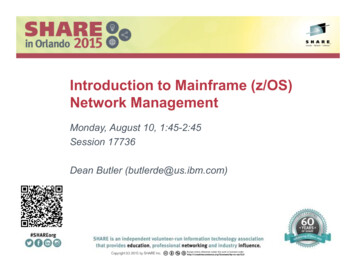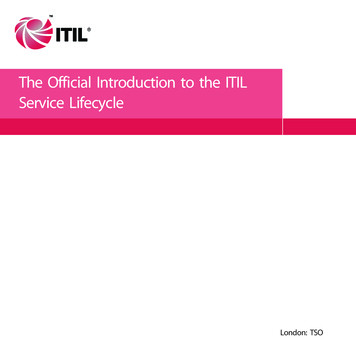
Transcription
Introduction to LAPACKZhiyu Zhao (sylvia@cs.uno.edu)The LONI Institute&Department of Computer ScienceCollege of SciencesUniversity of New Orleans03/16/2009
OutlineWhat is LAPACK Linear Algebra PACKage Problems Solved by LAPACK Matrices Handled by LAPACKStructure of LAPACK Driver Routines Computational Routines Auxiliary Routines LAPACK Naming Scheme
Outline (continued)Use LAPACK with Your Program Availability of LAPACK on LONI Clusters Get Information about a Routine on a Cluster Use LAPACK Routines in Your Fortran Program Use LAPACK Routines in Your C Program Use LAPACK Routines in Your C ProgramParallel and Distributed Programming with LAPACK Multithreaded LAPACK ScaLAPACK: Scalable LAPACK Software Hierarchy Intel MKL
What is LAPACKLinear Algebra PACKageA free package of linear algebra subroutines writtenin FortranLatest version: 3.2 (Nov. 18, 2008)Website: http://www.netlib.org/lapack/
What is LAPACKProblems Solved by LAPACKSystems of linear equationsLinear least squares problemsEigenvalue problemsSingular value problemsAssociated computations Matrix factorizations (LU, Cholesky, QR, SVD, Schur,generalized Schur) Reordering of the Schur factorizations Estimating condition numbers
What is LAPACKMatrices Handeled by LAPACKDense and band matrices (not general sparsematrices)Real and complex matricesSingle and double precision matrices
Structure of LAPACKDriver RoutinesEach solves a complete problem and calls asequence of computational routinesProblems solved Linear Equations Linear Least Squares (LLS) Problems Generalized Linear Least Squares (LSE and GLM) Problems Standard Eigenvalue and Singular Value Problems Generalized Eigenvalue and Singular Value ProblemsFor a complete list of driver routines, visithttp://www.netlib.org/lapack/lug/node25.html .
Structure of LAPACKComputational RoutinesEach performs a distinct computational taskUse them when driver routines are not the bestchoiceProblems solved Linear EquationsOrthogonal Factorizations and Linear Least SquaresProblemsGeneralized Orthogonal Factorizations and Linear LeastSquares ProblemsSymmetric Eigenproblems
Structure of LAPACKComputational RoutinesProblems solved (continued) Nonsymmetric Eigenproblems Singular Value Decomposition Generalized Symmetric Definite Eigenproblems Generalized Nonsymmetric Eigenproblems Generalized (or Quotient) Singular Value DecompositionFor a complete list of computational routines, visithttp://www.netlib.org/lapack/lug/node37.html .
Structure of LAPACKAuxiliary RoutinesRoutines that subtasks of block algorithmsRoutines that perform some commonly requiredlow-level computationsA few extensions to the BLAS (Basic Linear AlgebraSubprograms)For a complete list of auxiliary routines, visithttp://www.netlib.org/lapack/lug/node144.html .
Structure of LAPACKLAPACK Naming SchemeEach routine has a 6-character name Some driver routines have 5 only (the 6th is blank)All driver and computational routines have names ofthe form XYYZZZ X: Data type (S – single real, D – double real, C – singlecomplex, Z – double complex)YY: Matrix type (e.g. BD – bidiagonal, DI – diagonal)See http://www.netlib.org/lapack/lug/node24.html for a completelist of matrix types. ZZZ: Computation performed (e.g. SVX – an expert driverwhich solves AX B, QRF – QR factorization)
Use LAPACK with Your ProgramAvailability of LAPACK on LONI ClustersSoftware version: 3.1.1Installed on: Queen Bee, Louie, Eric, Poseidon,Oliver, and PainterTo make sure LAPACK is installed on a cluster, logonthat cluster and run the following command: softenv grep lapackYou should see one or more keys for LAPACK.
Use LAPACK with Your ProgramGet Information about a Routine on a ClusterLogon a LONI clusterRun the following command man routine nameLAPACK routinee.g. man dgesvd# routine name is the name of a
Use LAPACK with Your ProgramUse LAPACK Routines in Your Fortran ProgramCall routines as Fortran built-in functionse.g. CALL DGESV( N, NRHS, A, LDA, IPIV, B, LDB, INFO )Compile with the library lapacke.g. ifort –llapack –o filename filename.f
Use LAPACK with Your ProgramUse LAPACK Routines in Your C ProgramRoutine must be declared with externe.g. extern void dgetrf (int*, int*, double*, int*, int*, int*);Arguments must be passed by reference Pointers to variables instead of variable valuesMatrices must be transposed In C matrices are stored in row major order In Fortran matrices are stored in column major orderRoutine name is in lower case and followed by an ‘ ’e.g. dgetrf (&m, &n, (double*)A, &lda, IPIV, &info);Compile with the library lapacke.g. icc –o filename filename.c –llapack
Use LAPACK with Your ProgramUse LAPACK Routines in Your C ProgramAll rules for C apply (see the previous slide) exceptthat routine must be declared with extern "C“e.g.extern "C" dgetrf (int*, int*, double*, int*, int*, int*);Compile with the library lapacke.g. icpc –o filename filename.c –llapack
Use LAPACK with Your ProgramLab 1: Using LAPACK in Your CodeWrite a Fortran/C/C program which uses theLAPACK routine DGESV to solve a system of linearequations AX B, where12310A 456and B 0 17 8 1000Hint: man dgesv to get more information about thisroutine.Compile your code with –llapack .
Use LAPACK with Your ProgramAnswer to Lab 1 (Fortran)PROGRAM LapackLab1c ifort –o Lab1f Lab1.f -llapackINTEGER IPIV(3), infoDOUBLE PRECISION A(3,3), B(3,2)A(1,1) 1A(1,2) 2 A(3,3) 10c Continued on next slide
Use LAPACK with Your ProgramAnswer to Lab 1 (Fortran continued)B(1,1) 1B(2,1) 0 B(3,2) 0CALL DGESV(3, 2, A, 3, IPIV, B, 3, info)c If DGESV is called successfully info should be 0.IF (info .EQ. 0) THENDO i 1,3WRITE(*,'(2F8.3)') (B(i,j), j 1,2)ENDDOENDIFEND
Use LAPACK with Your ProgramAnswer to Lab 1 (C)/* icc –o Lab1c Lab1.c –llapack*//* Routine must be declared with extern.*/extern void dgesv (int*, int*, double*, int*, int*, double*, int*,int*);int main () {int n, nrhs, lda, ldb, IPIV[3], infodouble A[3][3], B[2][3];/* Matrices must be transposed.*/A[0][0] 1; A[1][0] 2; A[2][2] 10;B[0][0] 1; B[0][1] 0; B[1][2] 0;
Use LAPACK with Your ProgramAnswer to Lab 1 (C continued)/* Arguments must be passed by reference.*/n 3; nrhs 2; lda 3; ldb 3;/* Routine name is in lower case and followed by anunderscore ‘ ’.*/dgesv (&n, &nrhs, A, &lda, IPIV, B, &ldb, &info);/* Print the result. B should be transposed back.*//* If DGESV is called successfully info should be 0.*/if (info 0)for (i 0; i 3; i )printf("%8.3f %8.3f\n", B[0][i], B[1][i]);}
Use LAPACK with Your ProgramAnswer to Lab 1 (C )// icpc –o Lab1cpp Lab1.cpp –llapack#include iostream #include iomanip using namespace std;// Routine must be declared with extern "C".extern "C" void dgesv (int*, int*, double*, int*, int*, double*, int*,int*);int main () {int n, nrhs, lda, ldb, IPIV[3], info;double A[3][3], B[2][3];// Matrices must be transposed.A[0][0] 1; A[1][0] 2; A[2][2] 10;B[0][0] 1; B[0][1] 0; B[1][2] 0;
Use LAPACK with Your ProgramAnswer to Lab 1 (C continued)// Arguments must be passed by reference.n 3; nrhs 2; lda 3; ldb 3;// Routine name is in lower case and followed by an underscore‘ ’.dgesv (&n, &nrhs, (double*)A, &lda, IPIV, (double*)B, &ldb,&info);// Print the result. B should be transposed back.// If DGESV is called successfully info should be 0.if (info 0)for (i 0; i 3; i )cout setprecision(3) fixed setw(8) B[0][i] ' ' setw(8) B[1][i] endl;}
Use LAPACK with Your ProgramSolution to the Linear Equations in Lab 1-0.667 -1.333X -0.6673.6671.000 -2.000
Parallel and Distributed Programmingwith LAPACKMultithreaded LAPACKReference LAPACK does not support multithreadingSome vendor versions of LAPACK do Intel Math Kernel Library (Intel na/eng/307757.htmAMD Core Math Library Pages/default.aspx
Parallel and Distributed Programmingwith LAPACKScaLAPACK: Scalable LAPACKA free package of linear algebra subroutines writtenin FortranDesigned for distributed-memory message-passingMIMD computers and networks of workstationssupporting PVM and/or MPIWebsite: http://www.netlib.org/scalapack/Latest version: 1.8.0 (Apr 5, 2007)Note: Intel MKL provides ScaLAPACK subroutines.
Parallel and Distributed Programmingwith LAPACKScaLAPACK: Scalable LAPACKEach ScaLAPACK routine has a LAPACK equivalentNaming scheme: LAPACK name preceded by a ‘P’4 basic steps required to call a ScaLAPACK routine Initialize the process grid Distribute matrices on the process grid Call the ScaLAPACK routine Release the process gridFor more information, view ScaLAPACK user’s guide athttp://www.netlib.org/scalapack/slug/index.html .
Parallel and Distributed Programmingwith LAPACKSoftware HierarchyCited from http://www.netlib.org/scalapack/slug/node11.html .
Parallel and Distributed Programmingwith LAPACKSoftware HierarchyBLAS: Basic Linear Algebra Subprograms Subroutines that provide standard building blocks forperforming basic vector and matrix operations. Used by LAPACK and PBLAS Reference BLAS: a Fortran77 implementation Website: http://www.netlib.org/blas/ Optimized BLAS librariesSee http://www.netlib.org/blas/faq.html#5Note: Intel MKL provides optimized BLAS subroutines.
Parallel and Distributed Programmingwith LAPACKSoftware HierarchyBLACS: Basic Linear Algebra CommunicationSubprograms A linear algebra oriented message passing interface Uses message passing primitives such as MPI and PVM Used by PBLAS Website: http://www.netlib.org/blacs/PBLAS: Parallel BLAS Uses BLAS and BLACS Used by ScaLAPACKSee http://www.netlib.org/scalapack/slug/node14.html
Parallel and Distributed Programmingwith LAPACKIntel MKLIntel Math Kernel LibraryContains the complete set of functions from BLAS / Sparse BLAS / CBLAS LAPACK ScaLAPACK FFT Latest version: 10.1Website: ng/307757.htm
Parallel and Distributed Programmingwith LAPACKIntel MKLMultithreading implemented with OpenMP Providing multithreaded BLAS and LAPACK routinesMessage passing implemented with MPI Providing MPI based ScaLAPACK routinesAvailability on LONI clusters: Queen Bee, Eric, Louie,Poseidon, OliverFor more information, view Intel MKL user’s guide /eng/345631.htm .
Parallel and Distributed Programmingwith LAPACKIntel MKLHow to compile code with MKL on LONI clusters Use MKL for multithreaded routines with OpenMP compiler –openmp filename –L path of mkl lib -lmklNote: compiler is a Fortran/C/C compiler .e.g. on Queen Bee with Intel MKL 10.0 installed: compiler –openmp filename -L/usr/local/compilers/Intel/mkl-10.0/lib/em64t -lmkl Use MKL for ScaLAPACK routines with MPI & OpenMP mpi compiler –openmp filename –L path of mkl lib lmkl scalapack lp64 -lmkl blacs lp64 -lmkl lapack –lmklNote: mpi compiler is a MPI Fortran/C/C compiler .
Parallel and Distributed Programmingwith LAPACKLab 2: Using Intel MKL with Multithreaded LAPACKWrite a Fortran/C/C program which uses theLAPACK routine DGETRF to compute the LUfactorization of a matrix of2000*2000 randomentries.Record the execution time of the DGETRF routineonly (not including the time of generating randomentries), and display that time.Compile your code on Queen Bee with –llapack and–openmp –lmkl, respectively, and observe thedifference between the execution times.
Parallel and Distributed Programmingwith LAPACKAnswer to Lab 2 (Fortran)PROGRAM LapackLab2c ifort -o Lab2f Lab2.f -llapackc ifort -o Lab2f Lab2.f -L /usr/local/compilers/Intel/mkl-10.0/lib/em64t-lmkl -openmpUSE IFPORTINTEGER IPIV(2000), info, i, j, start, end, rate, max, elapsedDOUBLE PRECISION A(2000,2000)DO i 1, 2000DO j 1, 2000A(i,j) RAND()ENDDOENDDO
Parallel and Distributed Programmingwith LAPACKAnswer to Lab 2 (Fortran continued)CALL SYSTEM CLOCK(start, rate, max)CALL DGETRF(2000, 2000, A, 2000, IPIV, info)CALL SYSTEM CLOCK(end, rate, max)elapsed (end-start)*1000/ratec If DGETRF is called successfully info should be 0.IF (info .EQ. 0) THENWRITE (*, '(A, I, A)') 'DGETRF is done. : ', elapsed, ' ms.'ENDIFEND
Parallel and Distributed Programmingwith LAPACKAnswer to Lab 2 (C)/* icc -o Lab2c Lab2.c –llapack*//* icc -o Lab2c Lab2.c -L /usr/local/compilers/Intel/mkl-10.0/lib/em64t lmkl -openmp*/#include stdlib.h #include stdio.h #include time.h #define M2000#define N2000extern void dgetrf (int*, int*, double*, int*, int*, int*);int main () {int m M, n N, lda M, IPIV[N], info, i, j;double A[N][M];clock t start, end;
Parallel and Distributed Programmingwith LAPACKAnswer to Lab 2 (C continued)for (i 0; i n; i )for ( j 0; j m; j )A[i][ j] (double)rand();start clock();dgetrf (&m, &n, (double*)A, &lda, IPIV, &info);end clock();/* If DGETRF is called successfully info should be 0.*/if (info 0)printf("dgetrf is done: %d ms.\n", (int)((endstart)*1000/CLOCKS PER SEC));}
Parallel and Distributed Programmingwith LAPACKAnswer to Lab 2 (C )/* icpc -o Lab2cpp Lab2.cpp –llapack*//* icpc -o Lab2cpp Lab2.cpp -L /usr/local/compilers/Intel/mkl10.0/lib/em64t -lmkl -openmp*/#include iostream #include ctime using namespace std;#define M2000#define N2000extern "C" void dgetrf (int*, int*, double*, int*, int*, int*);int main () {int m M, n N, lda M, IPIV[N], info, i, j;double A[N][M];clock t start, end;
Parallel and Distributed Programmingwith LAPACKAnswer to Lab 2 (C continued)for (i 0; i n; i )for ( j 0; j m; j )A[i][ j] (double)rand();start clock();dgetrf (&m, &n, (double*)A, &lda, IPIV, &info);end clock();/* If DGETRF is called successfully info should be 0.*/if (info 0)cout "dgetrf is done: " ((endstart)*1000/CLOCKS PER SEC) " ms." endl;}
Parallel and Distributed Programmingwith LAPACKLab 3: Using Intel MKL with ScaLAPACKOn Queen Bee, go to your work directory anddownload an example Fortran program from theofficial website of ScaLAPACK. wget fCompile the example program mpif77 -openmp -o example1 example1.f -L/usr/local/compilers/Intel/mkl-10.0/lib/em64t lmkl scalapack lp64 -lmkl blacs lp64 -lmkl lapack –lmkl
Parallel and Distributed Programmingwith LAPACKLab 3: Using Intel MKL with ScaLAPACKWrite a job submission script file and save it asexample1.pbs#!/bin/bash#PBS -A your allocation name#PBS -q checkpt#PBS -l nodes 6:ppn 8#PBS -l walltime 00:10:00#PBS -o example1 output#PBS -j oe#PBS -N example1mpirun -np 6 example1
Parallel and Distributed Programmingwith LAPACKLab 3: Using Intel MKL with ScaLAPACKSubmit the jobWait for the job to be completed and check itsoutput in the file example1 outputYou should see
Thank you!Questions / Comments?
Mar 16, 2009 · Write a Fortran/C/C program which uses the LAPACK routine DGETRF to compute the LU factorization of a matrix of2000*2000 random entries. Record the execution time of the DGETRF routine only (not including the time of generating random entries), and display th











